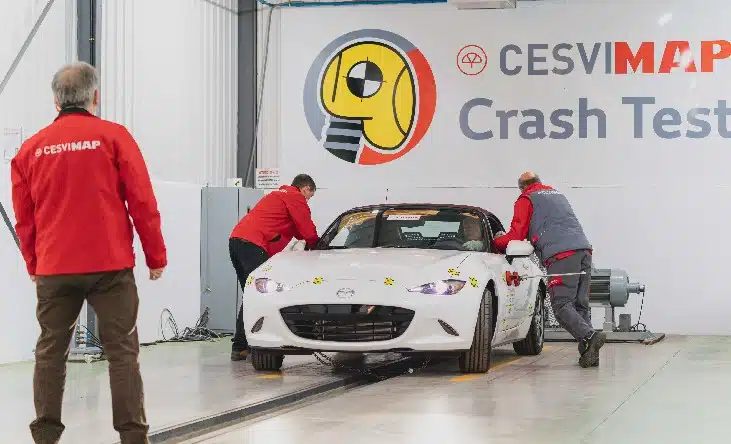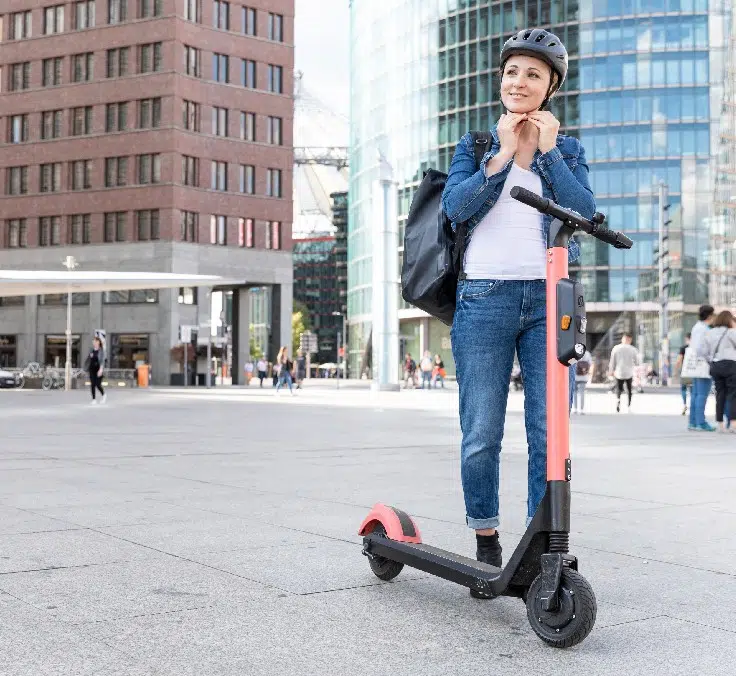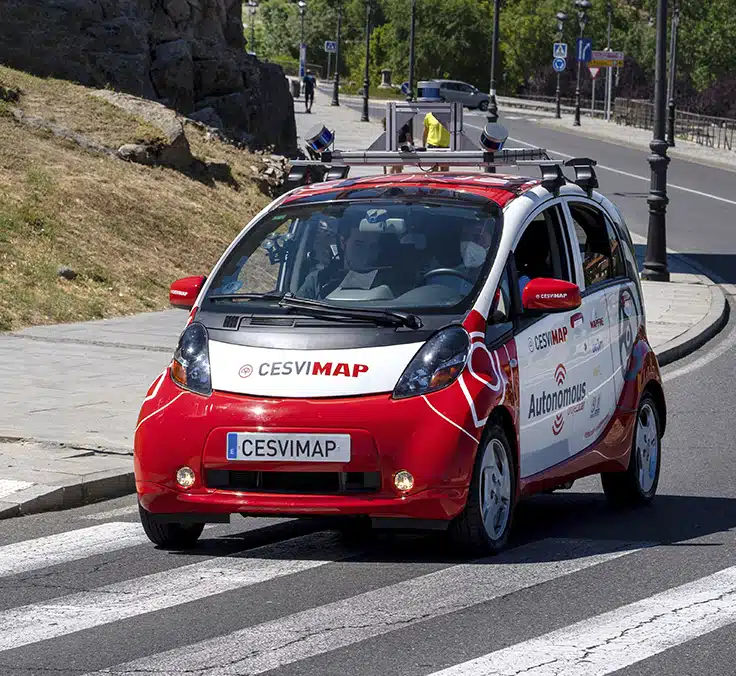INNOVATION| 05.07.2023
Innovation: part of CESVIMAP’s DNA for 40 years
Accident reconstruction projects using geolocation and digital twin solutions; research on advanced driver assistance systems and autonomous driving and robots; and crash testing for reparability are just a few of the innovation-based initiatives taking place at MAPFRE’s R&D center.
CESVIMAP is MAPFRE’s R&D center, and it’s part of the MAPFRE Open Innovation model. As MAPFRE’s Experimentation and Road Safety Center, it’s the company’s innovation laboratory for new Usage Based Insurance (UBI) products and services.
In addition to being a world-renowned technology center focused on design, insurance, usage, maintenance, repair, and recycling of vehicles and other mobility solutions for people and cargo, the professionals at CESVIMAP are always looking for ways to generate value for society. They do this by creating innovative developments in all types of settings, including everything from consultation and training to sharing know‑how and promoting circular economies.
This year, the center is celebrating its 40th anniversary. To recognize this important milestone, in this article we will describe some of the innovative projects taking place at CESVIMAP.
Using AI and Deep Learning for motors insurance damage analytics
CESVIMAP has developed an artificial intelligence (AI) model with a deep learning algorithm, which is making it possible to perform immediate digital contracting of insurance for used vehicles. This AI model can detect dents, scratches, and other minor bodywork damage in real time using photos taken with a mobile phone.
This predictive model has been trained using millions of very diverse images, along with the expected response for each of them. This has now made it possible for the program to identify possible vehicle damage with more than 95% accuracy. In addition to motors insurance, this system can also be applied to contracting of home and business insurance, to speed up the procedures and give customers a simple yet personalized experience.
Mobility and ADAS
CESVIMAP is studying Connected / Autonomous / Shared / Electric (CASE) mobility. It was the first research center to study an electric car, in 2011, before the boom in electric micromobility we are now experiencing more than a decade later.
In collaboration with Fundación MAPFRE, the center has designed simulations for personal mobility vehicles (PMVs) using finite element analysis. Based upon these results, the ratios were studied using real crash tests between electric scooters and vehicles and pedestrians, using a special device registered with Spain’s Patent and Trademark Office.
Since 2015, CESVIMAP has been testing advanced driver assistance systems (ADAS), as precursors to future autonomous driving technologies. The purpose is this testing is to evaluate a vehicle’s ability to avoid accidents, and therefore prevent personal injuries and property damage. This is done by analyzing the incorporated sensors (cameras, radar, lidar), along with their repair costs and the benefits they produce.
Crash tests
CESVIMAP has developed an extensive body of knowledge by studying new models of vehicles. Specifically, in its crash test area the center has tested more than 800 vehicles (cars, vans, motorcycles, electric scooters, etc.), using low‑speed impacts. In this way, it has completed 650 research and development projects, and has even registered its own patents in relation to the vehicle testing performed. Those tests also include analysis of the associated repair needs and costs, as well as welding systems.
The research work performed by CESVIMAP is complemented by the work it performs for traffic accident reconstruction, which makes it possible to determine what happened before an accident occurred, and to issue reports that can be used as evidence in court cases. This can help improve road safety by providing information about the effects of the human factor, the road, weather conditions, the condition of vehicles, and the functioning of safety elements.

Accident reconstruction using new technologies
When discussing accident reconstruction, it’s also worth mentioning the MAPFRE R&D center’s initiatives in this field.
Traditionally, an appraiser would visit the location where an accident occurred, to perform an in‑situ analysis. However, thanks to new technological developments, the accident reconstruction process has completely changed.
By using geographic information systems (GIS) and cartography applications, along with LiDAR point cloud data, photogrammetry, and other 3D applications, digital twins are created to allow virtual reconstruction of an accident or other claimable event. This approach makes it possible to explore every detail, with precision measurement and investigation of each road surface and vehicle. This produces the best understanding of the circumstances that occurred, while also detecting specific aspects that may not have been noticeable at the actual location.
The Second Life and Batraw projects for extending the life of EV batteries
The evolution of electric vehicles depends upon the batteries they use, and mitigating the environmental impact of their manufacturing process, as well as extending their useful life, are two challenges that the industry needs to address immediately to achieve its goals on sustainability.
Until now, batteries recovered from EVs destroyed in accidents have been treated as waste, with the recycling of their elements being the only possible form of management. This is why finding better ways to reuse batteries has become a priority, and MAPFRE’s R&D center therefore launched its Second Life project, an initiative based on giving those batteries a second life by recycling their internal modules.
The project, which began in 2021, evaluates the battery to determine different ways to reuse it: if it is in good condition, it can be used as a replacement in another electric vehicle, or to repair damaged modules in other batteries, or it can become part of a charging station (either fixed or portable, and of various sizes). Finally, a battery’s critical raw materials can also be extracted for other uses.
In addition to this initiative, CESVIMAP is also participating in the Batraw project, as part of the Horizon Europe program. The aim of this project is to create new processes for assembly and repair of electric vehicle batteries, and for diagnosing their state of health.
Autonomous driving and autonomous delivery robots
MAPFRE is the first insurance company to build an independent testing platform to investigate autonomous driving technologies and their associated risks.
CESVIMAP has been working on this project since 2018, in collaboration with the Polytechnic University of Madrid’s INSIA and the Carlos III University of Madrid’s Intelligent Systems Laboratory. The project has developed and tested aspects such as computer vision to perceive a vehicle’s surroundings, vehicle-to-everything communication capabilities, human-machine interaction, etc., along with positioning and environment simulation for digital recreations.
In 2022, this project introduced its first prototype for an autonomous car, which was demonstrated with a successful drive around an urban environment.
In addition, CESVIMAP is already working on analytics and research for delivery robots, which are able to travel along the sidewalks of major cities in a fully autonomous manner. Specifically, the “last mile” delivery robots used by Goggo Network have been the focus of this work, with risks and opportunities identified in relation to their current performance, along with their potential for travelling along roads.
IBIS Iberia 2023
Coinciding with CESVIMAP’s 40th anniversary, the experimental centre is hosting the IBIS IBERIA international congress next September 2023, a global event which, for the first time, is being held in southern Europe. IBIS Worldwide is the world’s leading repair market conference.
IBIS Iberia 2023 will take place on 19 September 2023 at the Palacio de Congresos Lienzo Norte in Avila (Spain). This automotive conference is based around the theme “Sustainable Strategies for Success”. It is a great opportunity to learn about trends, best practices and share innovations that contribute to improve the profitability of the Iberian repair market (Spain and Portugal).
RELATED ARTICLES:



